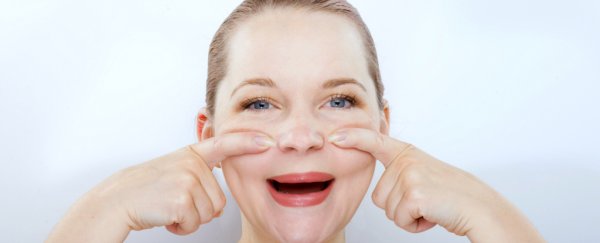When it comes to ageing, many of us would like to look younger, but most anti-ageing remedies not only aren't back up by science, they're also prohibitively expensive, or painful. Or both.
Now, scientists have found early evidence that a free and non-invasive technique can actually make people's faces look visibly younger in just 20 weeks - facial yoga.
Don't laugh, because we fully appreciate how ridiculous that sounds. But researchers from Northwestern University in Illinois were able to show that by spending 30 minutes a day exercising the muscles in your face, it's possible to tighten and lift the cheek areas to look more youthful.
People have been doing these types of facial exercises, or facial yoga, for years, but this is the first study to look into whether it actually works.
"Now there is some evidence that facial exercises may improve facial appearance and reduce some visible signs of ageing," said lead author Murad Alam, a dermatologist from Northwestern University.
"The exercises enlarge and strengthen the facial muscles, so the face becomes firmer and more toned and shaped like a younger face."
To be clear, this was a proof-of-concept study and only involved a small sample size of 16 people who completed the full 20-week program. So before we get too excited, this research needs to be replicated in a much larger group.
But it does offer some hope that we don't need to spend hundreds of dollars on our faces in order to make them look younger.
"Assuming the findings are confirmed in a larger study, individuals now have a low-cost, non-toxic way for looking younger or to augment other cosmetic or anti-aging treatments they may be seeking," said Alam.
The study worked like this - 16 women aged between 40 and 65 were recruited, and underwent two face-to-face, 90-minute training sessions with a facial exercise instructor.
Over the next 20 weeks they were told to continue the exercises at home - for the first eight weeks they did them for 30 minutes a day, and for the rest of the time they did the same exercises every other day.
The exercises involved learning 32 different facial expressions, which were each held for about a minute.
For example there's "The Cheek Lifter", where you open your mouth and form an O shape.
With your lips over your teeth, you smile to lift your cheek muscles up, placing your fingers lightly on the top part of the cheek so you can feel them lifting. You repeat this for a minute by lowering and lifting the cheeks.
Another exercise is called "The Happy Cheeks Sculpting": Purse your lips to cover your teeth and then smile forcing your cheek muscles up, placing fingers on the corners of your mouth and sliding them up to the top of the cheeks. You hold this for 20 seconds.
The change was measured through photographs and blind assessed by dermatologists - which means they didn't know the participants or anything about the study.
These dermatologists assessed the photos using a standardised facial ageing scale and rated 19 features on each face at the beginning, middle, and end of the study.
At the start of the study, the dermatologists rated the patients to be 50.8 years on average, and that dropped to 48.1 over the course of the study.
"That's almost a three-year decrease in age appearance over a 20-week period," Alam said.
The most dramatic effect was upper and lower cheek fullness, which rounded out and appeared fuller throughout the study.
Of course, this is an incredibly small sample size, and it's limited by being made up solely of middle-aged women - we have no evidence as yet that facial yoga would work in other demographics.
The study also didn't mention or monitor what else the women were doing to their faces throughout the experiment.
But it's promising early evidence that simply by toning our faces like we do our bodies, we could make ourselves look younger.
The study didn't look into how facial yoga might deliver results, but the team explains that as the face ages, skin loses elasticity and the fat pads between the muscle and skin become thinner. This causes the skin and face to drop.
"But if muscle underneath becomes bigger, the skin has more stuffing underneath it and the firmer muscle appears to make the shape of the face more full," said senior author Emily Poon.
"Muscle growth is increasing the facial volume and counteracting the effects of age-related fat thinning and skin loosening."
There's definitely not enough evidence as yet to start adding facial yoga to your daily routine, but it's definitely something worth thinking about next time you spend hundreds of dollars on the latest anti-ageing fad.
The research has been published in JAMA Dermatology.
